#learn from eBay experts
Explore tagged Tumblr posts
Text
How This eBay Seller Retired at 40 Reselling Pre-Owned Clothes — And His Warning About 2 Big Mistakes Every Beginner Makes
Master the Art of eBay Reselling: Tips from a Pro Who Retired at 40 by Selling Pre-Owned Clothes Retired at 40? Discover This eBay Seller’s Secrets (and Avoid These Mistakes!) In 2008, Alex T. took his first step into the world of eBay reselling. What began as a solution to offload a broken cellphone turned into a full-fledged business empire. Today, at 40 years old, he’s retired, thanks to the…
#apple#avoid eBay reseller pitfalls#eBay#eBay business tips#eBay reselling advice#eBay reselling mistakes#ebay seller tips#fashion#financial independence journey#gadget lovers#gear#grow your eBay business#huawei#ipad#laptop#learn from eBay experts#market research for eBay sellers#online business success#poshmark#reselling#reselling for profit#retire early through e-commerce#selling pre-owned clothes#side hustle ideas#smartphone#tablet#tech#technology#top eBay seller strategies
0 notes
Text
Frogman's Camera Buying Guide
A few weeks ago someone asked if I could recommend an interchangeable lens camera (ILC) to supplement their smartphone photos and hopefully get better pictures of important things like vacations and pets.
I decided to go very extra with my response and due to that... I'm still not finished with it.
I'm worried I am letting this person down because they did not ask for a giant post explaining every detail about cameras in the history of forever.
So I am going to do a camera recommendation post without as much explanation and hopefully I can finish the giant post at some point in the near future.
If you want to take better pictures you are probably going to need a camera with a decent sized sensor, a fast lens, a tripod, and a flash.
The bigger sensor gives you more dynamic range so you can capture brighter and darker things in the photo.
A fast lens has a giant hole in the front that lets in a ton of light. That hole is called the aperture and the bigger it is, the better your photos in dark environments will be. So you will want something that does f/1.8 or f/1.4 (lower f-stop number = bigger hole = more light). This can also help you get a lot of cool background blur.
A tripod will help get you longer exposures without any blur from camera shake. Especially good for landscape photos.
And a flash is for taking photos of pets and other moving subjects when you are indoors and don't have a lot of light. A flash is an absolute game changer for indoor photos.
HOWEVER, never point it directly at your subject.
Point it at a large white ceiling or wall. The flash happens so fast that it freezes motion. It is how I got all of my indoor photos of Otis.
Here he was playing and being rambunctious and he is not blurry.
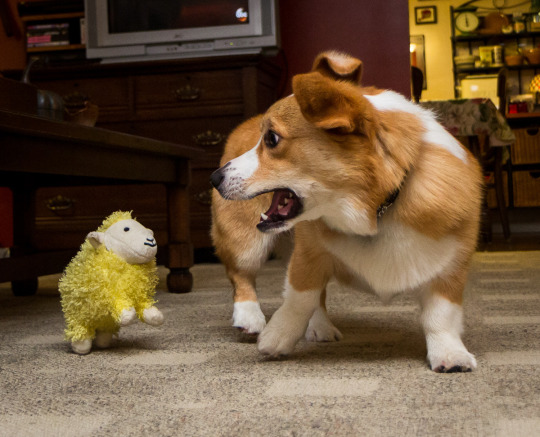
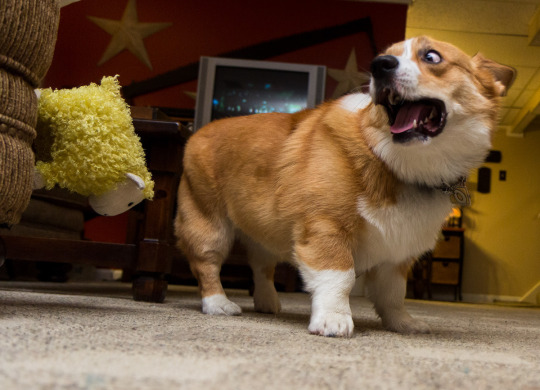
I used no special settings. I just stuck on a flash and pointed it at the ceiling and suddenly sheep are sticking to things.
Oh, and one other huge benefit of using a flash... you can take much better photos of pets with dark fur. So if you have a cute little void in your home, a flash can help you capture detail in their fur.
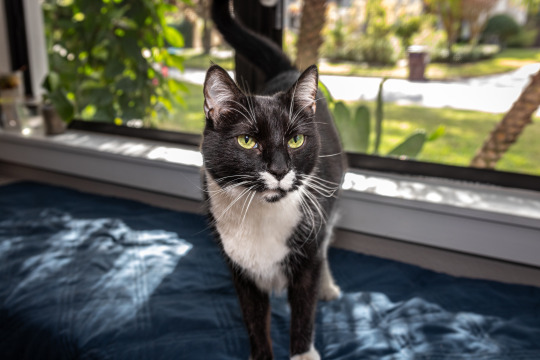
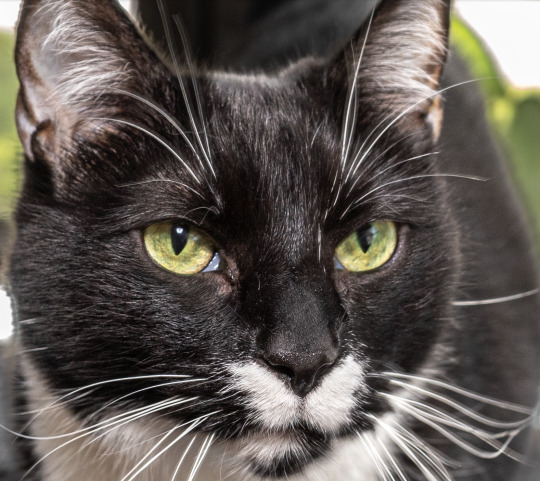
Just lift the shadow slider in your image editor and that beautiful fur will reveal itself.
If you get an ETTL or TTL flash, it will output the correct amount of light automatically. You can literally just put your camera in automatic mode, aim the flash at the ceiling, and press the shutter button.
Before I talk about recommendations I want to make one thing very clear.
GETTING A GIANT CAMERA WILL NOT AUTOMATICALLY GIVE YOU BETTER PHOTOS.
Aside from my flash aimed at the ceiling trick, a big boy camera is not a magic solution for better photos. In some cases, you might actually get *worse* photos than your smartphone. You need to learn the basic fundamentals of photography and you also need to learn some basic photo editing skills.
Smartphones employ powerful algorithms and computational processes to make every photo you take look as good as possible.
ILCs say, "Here is your RAW data, you figure out the rest."
You don't have to become an expert, but if you watch this free 6 hour photography course, that will ensure you have the knowledge needed to improve your photos.
youtube
Okay, let's get into the nitty gritty of buying a nice new old ILC.
If you are on a tight budget and cannot afford a fancy mirrorless camera, I would highly suggest a used DSLR. You can get them for very reasonable prices. And unlike just about every other modern technological gadget, cameras and lenses are built to last for decades. So I have no qualms about recommending used photography gear.
However, I do highly recommend using either KEH or MPB, as they have a long trial period and decent customer service. If something goes awry with your used gear, KEH has a 180 day warranty and MPB has a 6 month warranty. So there is much less of a risk than eBay or Facebook Marketplace. You pay a bit of overhead, but the piece of mind is worth it.
Before I start my recommendations I want to quickly explain the difference between APS-C and Full Frame camera bodies. (For brevity's sake I am going to omit Micro Four Thirds bodies as they are not typically geared toward beginner photography.)
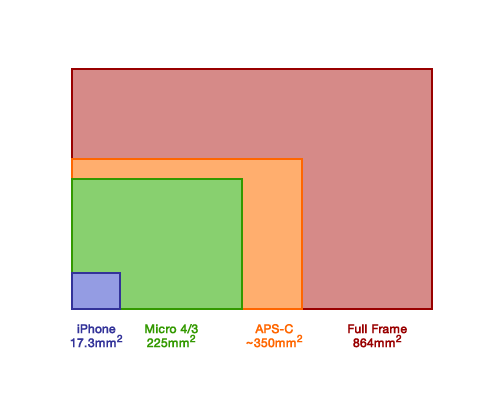
APS-C has a "crop" sensor. It is a bit smaller than full frame and does not perform as well in low light (more noise). However these bodies are cheaper and can still produce great photos. You can see above the sensor is still significantly larger than a smartphone. APS-C adds a 1.5x zoom to all lenses. This can be annoying in small spaces but advantageous for outdoor photography like wildlife and sports. You can use full frame lenses on a crop sensor body (within the same brand). APS-C lenses are usually cheaper but of lower quality.
Full frame has a larger sensor that will give you less noise in low light. It is also much easier to get background blur. Full frame also allows you to work in more cramped spaces. You *cannot* use APS-C lenses on a full frame body. However, the lenses meant for full frame cameras tend to be better quality in general.
If you can save up a little more and get a full frame body, I would recommend it. These bodies used to be geared more toward professional use, but since mirrorless cameras became popular, used full frame DSLRs have become much more accessible to those on a budget. Full frame cameras make it easier to get better results in challenging circumstances. And challenging conditions are really the main area where ILCs still kick a smartphone's ass.
For tight budgets I would recommend the following...
Canon or Nikon APS-C DSLR camera body
50mm f/1.8 lens (Nifty Fifty)
18-55mm APS-C lens (good for landscapes and portraits)
Yongnuo ETTL Flash
There are lenses called "superzooms" which can go from (as an example) 18-200mm or 70-300mm and other crazy focal lengths. That sounds fantastic and very versatile... but these are usually utter shite. You may be tempted to get one of these lenses hoping it can do everything you need, but there are no free lunches in lens land. Unless you are spending many thousands of dollars, the wider the focal range, the worse the lens will be.
When you stick to the 18-55mm range, you can be assured the images will be decent. And if you find yourself really needing a telephoto lens, you can save up and add it to your collection later on. The 18-55 will give you wide angle for landscapes all the way to slightly telephoto for portraits and moderately close wildlife. This lens cannot be used indoors or at night without a flash. Which is why I recommend the Nifty Fifty for that purpose. $100 for a moderately sharp low light lens is a no brainer.
Also, stick to Canon, Nikon, Sigma, or Tamron lenses. You can try exotic 3rd party lens brands when you know more what you are doing. And always make sure the lens has autofocus before buying.
It's hard to give you exact recommendations as used items are not reliably in stock. So I'm going to show you an example of the above, but I am not necessarily saying you should buy this *exact* combination. You might be able to get something similar with Nikon as well.
Canon 60D APS-C DSLR
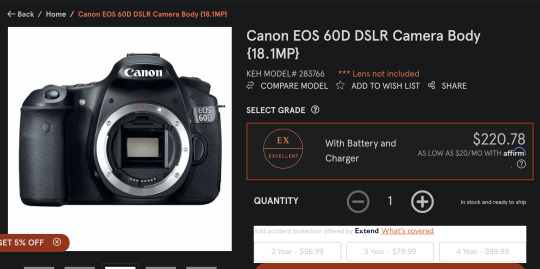
50mm f/1.8 lens

Canon 18-55mm APS-C lens (EF-S mount)

Yongnuo TTL Flash
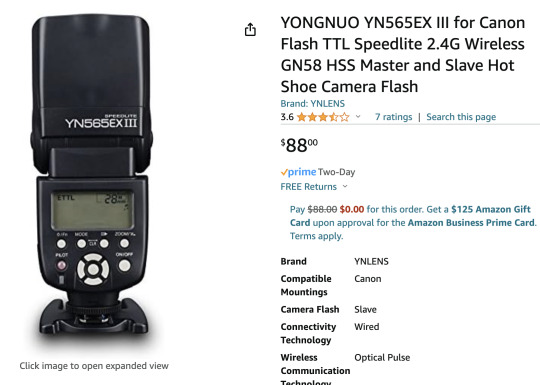
(I wouldn't recommend getting a used flash, as the Yongnuo is already a great price and you can't know if someone used the flash 100,000 times or 20 times.)
Altogether that is about $500. You can start with the 60D and the 50mm Nifty Fifty for $330 and add on the other two items later on.
My recommended full frame setup...
Full frame Canon or Nikon DSLR body
50mm f/1.8 lens (same as before)
24-70mm full frame zoom lens (full frame equivalent to 18-55mm)
ETTL Yongnuo flash (same as before)
And an example from KEH might be...
Canon 6D Full Frame DSLR


Canon 50mm f/1.8 Lens

Sigma 24-70mm Full Frame Zoom lens (EF mount)
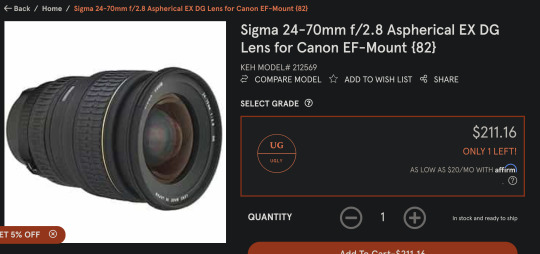
Yonguo ETTL Flash

And that would be about $800 total.
Again, you can start with just the camera and 50mm lens and add the other items later. So invest $500 initially and go from there.
And just to give a Nikon example as well...
Nikon D600 Full Frame DSLR
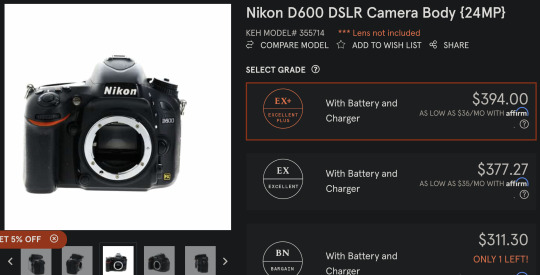
Nikon 50mm f/1.8 Lens
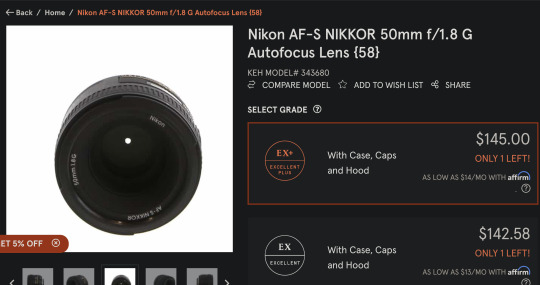
Tamron 24-70mm
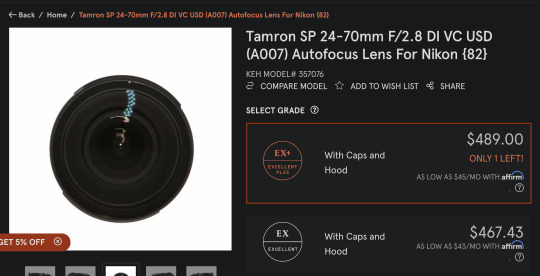
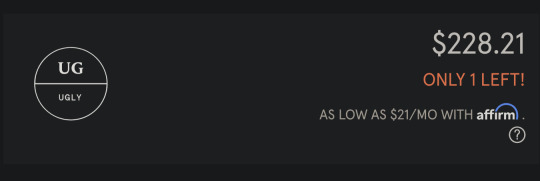
Yonguo ETTL Flash (Nikon version)

I highly recommend researching any camera body and lens before purchase. I can vouch for the items above, but you should definitely check out some YouTube videos before buying.
All of the stuff on KEH and MBP is marked down in price for aesthetic reasons. They do test everything to make sure it is functional. If you care if the camera or lens looks pristine, it will cost a little extra. But if you don't mind if it is beat to hell, you can save some money. Ugly or not, you will get the same photos out of the gear. As I said, photography stuff is built to last for a long time. Almost all repairs are due to user damage and not defects. And usually defects manifest when the product is brand new.
Oh, I forgot about the tripod!
Amazon's $35 tripod is surprisingly decent. It even got a good review on a very picky tripod review site. I recommend starting with this and then upgrading when you know more what you need out of a tripod.
Amazon 60 inch Tripod
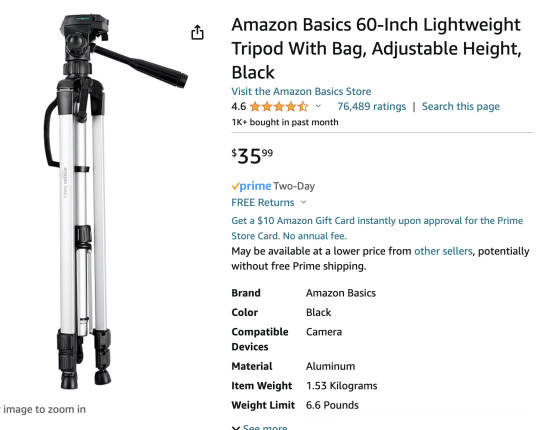
I worry I'm leaving out a lot of important information, but hopefully I can expand in the other post I am working on.
That said, if anyone is thinking of buying a camera and you are not sure about the items you selected, please feel free to message me and I will help you assess your choices. Please make sure you include a budget range when asking for buying advice.
I hope that helps. I will try to finish the more in depth post soon. And it will include tips for how to get better photos from your smartphone if you cannot afford an ILC at the moment.
Further resources...
Recipe for Landscape Photos Froggie's Encyclopedia of Lens Terms
204 notes
·
View notes
Text
Pitfalls of Pictures
As polar fandom works its way into ever more serious circles, from social sharing to published works, I thought I might share what I've learned about copyright and using pictures you find online.
Copyright belongs to the person who made the image. This means the artist or photographer in most cases. The photographer is the one who opened the shutter, not the owner of the camera.
Copyright, in most places and cases, lasts for the life of the creator +70 years.
Many Heroic Age polar images are therefore out of copyright. BUT WAIT. That's the photo. If you find it online, it's been digitised by someone. The copyright of the digitised image legally belongs to whichever person, or institution, digitised the image. Therefore the same Ponting photo can be copyright SPRI, Getty, RGS, or Anne Strathie, who scanned it off an original print she bought on eBay. Print: uncopyrighted. Scanned image: copyrighted. Even though the picture is the same, they are discrete things.
A lot of polar photos have been digitised by educational institutions or regional/national archives. They have to balance their mission to drive engagement with the necessity of licencing fees to fund their work. Everyone has a different way of doing this, so it's worth your while to learn the policies of wherever you found the photo.
For the most part (BUT NOT ALWAYS!) so long as you're not making any money on the image or using it to further your career (i.e. just fangirling) you're probably OK. People generally only bother to rally the expensive lawyers when there's cash involved. However it is always worthwhile to check, because there is nuance.
Posting an image which has not previously been public onto a public website (e.g. Tumblr) legally counts as publishing it. If you've been given permission to access it and/or make your own digital copy, that does not necessarily mean you can share it online. There may be different rules around publishing it vs having it, even for free.
Example: In 2014 I photographed all the negatives of Meares' Siberian photos at the BC Archives. I wanted a proper scan of a few of them, for an article I was co-writing at the time. I was allowed to take as many pictures as I liked with my own camera for personal use, and was charged a small fee for the scans. However, if I were going to publish any of them, I would have to fill out paperwork with the BC Archives and pay another, much larger fee. In 2023, I learned that the BC Archives had changed their policy: one needed only to credit the Archives for the photo, with their specified text. I finally got to write my post about Scott's ponies and throw in the photos for free. So keep up to date on usage permissions, too!
Downloading an image and sharing it amongst your friends, via email or messaging or some other closed network, without posting it on a public platform, is not the same as publishing it. But your friends need to be clear that they can't publish it either.
Going into the code of a photo site to find the high-res version of an image? Technically no one can stop you.
Publicly posting that high-res image, which the image holder has buried in code so that people can't distribute it? Not OK.
Printing off merch with that image and selling it as a side hustle? WOW VERY NO.
There is another slightly hazy area called 'transformative works' in which you can take a copyrighted image and change it enough to count as a new image. I don't know if there are any hard and fast rules on this – and they probably vary by jurisdiction – but as a rule of thumb, you're generally OK if no one in their right mind would mistake your image for the original.
I don't think any of us want to raise the ire of the heritage bodies which feed our passion for this stuff, so please make sure to stay on their good side! Photo archives take space and refrigeration and expert curators, which are all very expensive, and this is generally paid for by licensing the photos they keep. (The photo library at SPRI, for example, is the only part of the institution which makes any profit.) So please play nice!
I am far from being an authority on this, just sharing what I've learned over my 15+ years of working with polar photos on and offline. Please research your specific cases, and add anything to this post which you think may be relevant!
37 notes
·
View notes
Text
In the early 2000s, there was somebody whose user name I can't remember (seems like it had to do with flying pigs?) who sold custom dolls on eBay
The dolls were all fashion dolls, and the seller's Big Thing was creating sort of Fantasy Fairy costumes entirely from beads. The beading seemed detailed and competent, but I couldn't really judge because neither I nor any of my online doll friends did beading like that
What my online friends and I did do was paint dolls, and we could not contain our snark over the fact that this person was very obviously repainting these dolls with paint markers--early 2000s paint markers, so they would have been enamel and not very fine point
Well, actually, we did contain our snark to within our chats, but apparently some people had reached out to the seller and--hopefully gently--suggested that acrylic would be a better paint to use (again, this was the early 2000s, so the kind of 'layers of pastels and sealant' faceups didn't really exist yet)
And we knew this because the seller thanked them for the suggestion, because the seller had found that switching to acrylic paint was indeed better! ...as the dolls continued to be painted with the exact same thick-line look that the paint markers had created
I never knew if the seller was being passive aggressive--in fact, my (and my doll group's) snark was so high that I don't think it occurred to any of us that it could possibly have been done as an act of snark itself, instead of "completely obliviously," which just led to more snark
And of course we couldn't accept that people were happy to buy these dolls, no, we had to mock the idea of them, too, for buying those dolls whose paint we didn't like. I can't remember if we considered that people might have changed the dolls' heads (the clothes were probably not removable), or if we just assumed that the people buying them were oblivious to the crudeness that we saw in the repaints
And we weren't mocking that seller's work out of jealousy or envy--just about every person in that doll group was regularly selling dolls we'd repainted, too. If anything, that made us feel like were were more qualified to be experts in judging this other person's work, and other people's tastes
We were all horribly misguided, of course
I did not learn anything from that particular experience, and it would be years before I started to comprehend that "cruelty" and "humor" are not the same, and the idea of "not for me, move on" is the best way to approach things like that, especially when it's an individual artist. (incorporated entities who are making things they want as many people as possible to buy...might not get as much grace)
Anyway. I did eventually start trying to be kind, and have found that it did indeed become easier to be kind without so much effort
The snark does remain, just not so...rampant... And I know there are people out there whose image of me (positive or negative) is perpetually fixed in that cruel snark era. I can't do any more about that than I can do about when people have tastes different from mine. It's fine.
25 notes
·
View notes
Note
Where do you find all your neat little trinkets and such? Is it just accumulated over the years, or do you use marketplace, or antique malls, commissioning stuff? I want to add more to my home, but I don't really know where to look outside of hyper specific ebay searches.
I guess, more succinctly, how do you Find Things?
Heya! Finding cool stuff is a lot about doing just enough research. I'll show you how my mind works.
Let's say I saw this cute cat in the wild. I want to buy it, maybe see if it's something fun to collect.
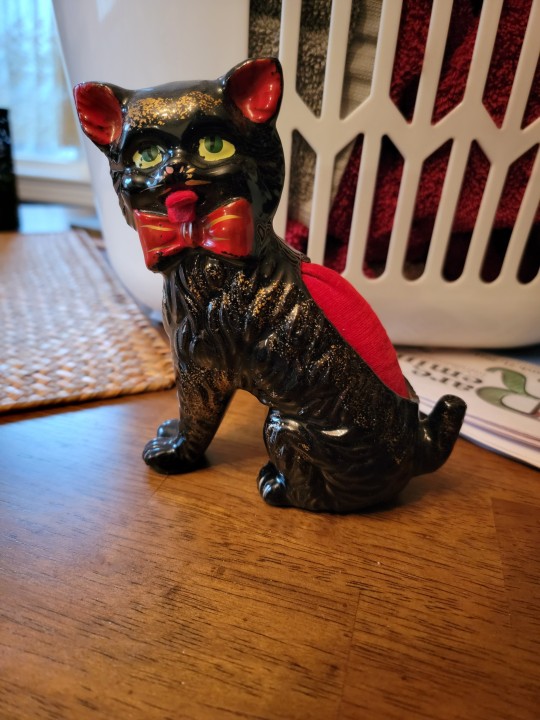
If I use Google lens on the photo, I get some promising results - this is something that was mass-produced!
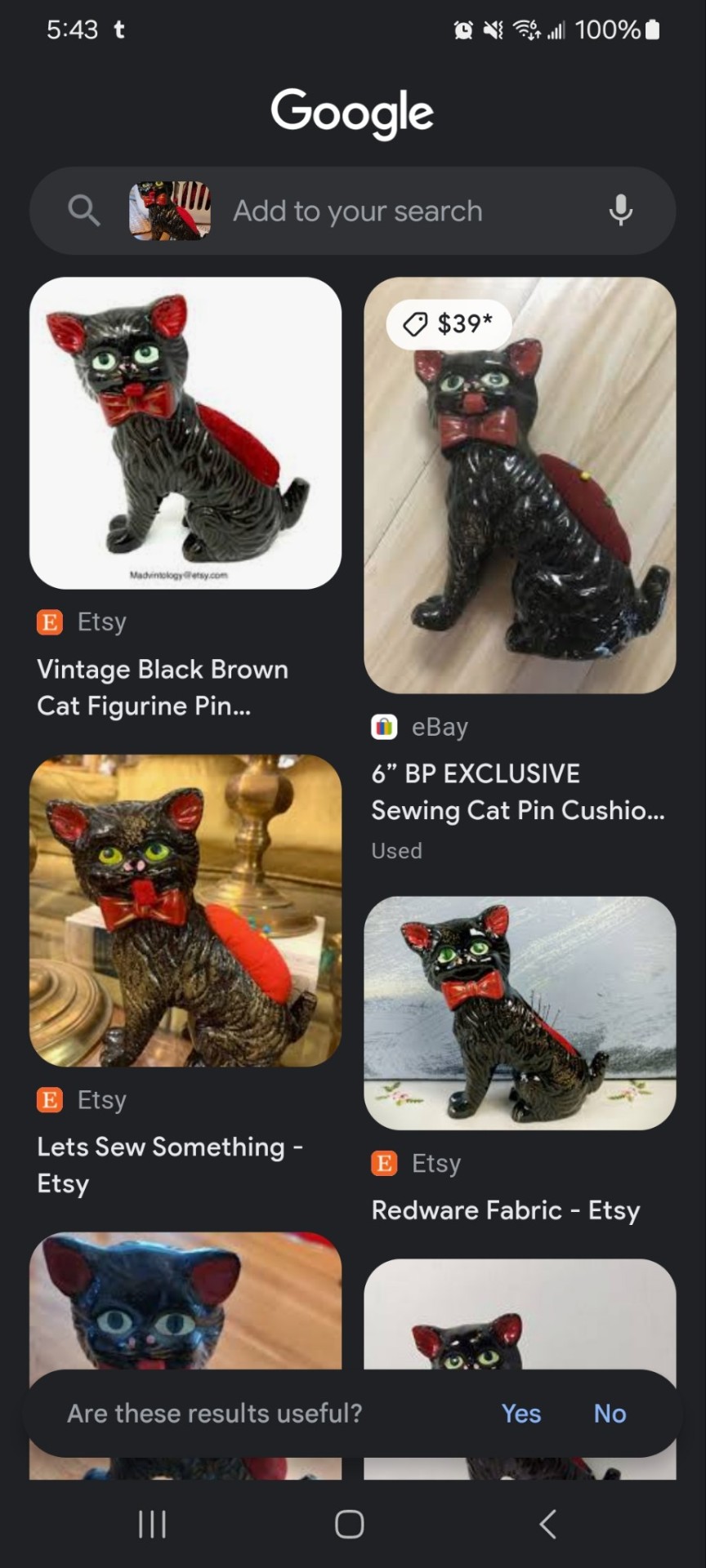
Let's click on a result.
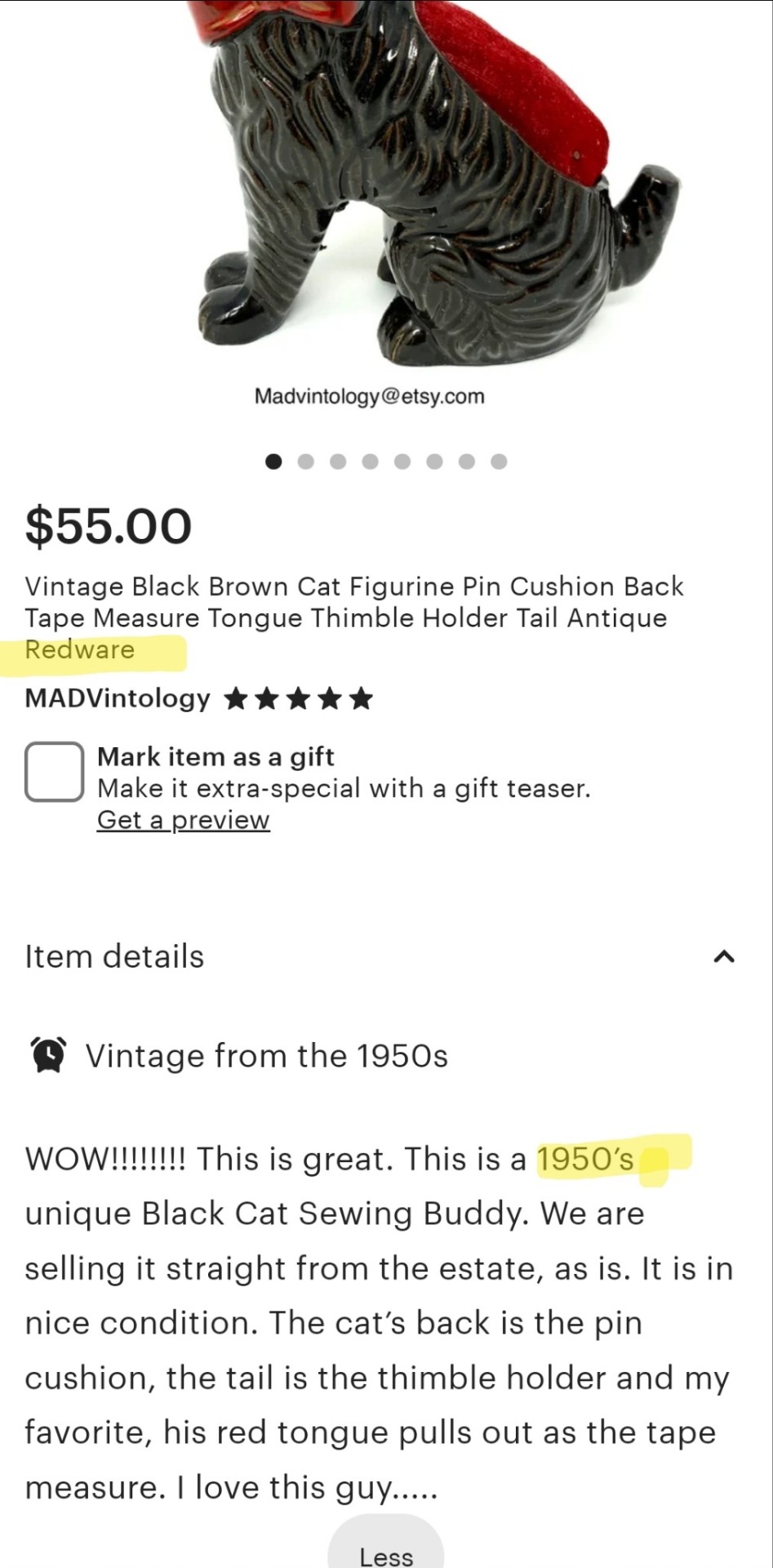
I've learned something! This ceramic is called "redware" and the figure is from the 1950s. So, off to another web search.
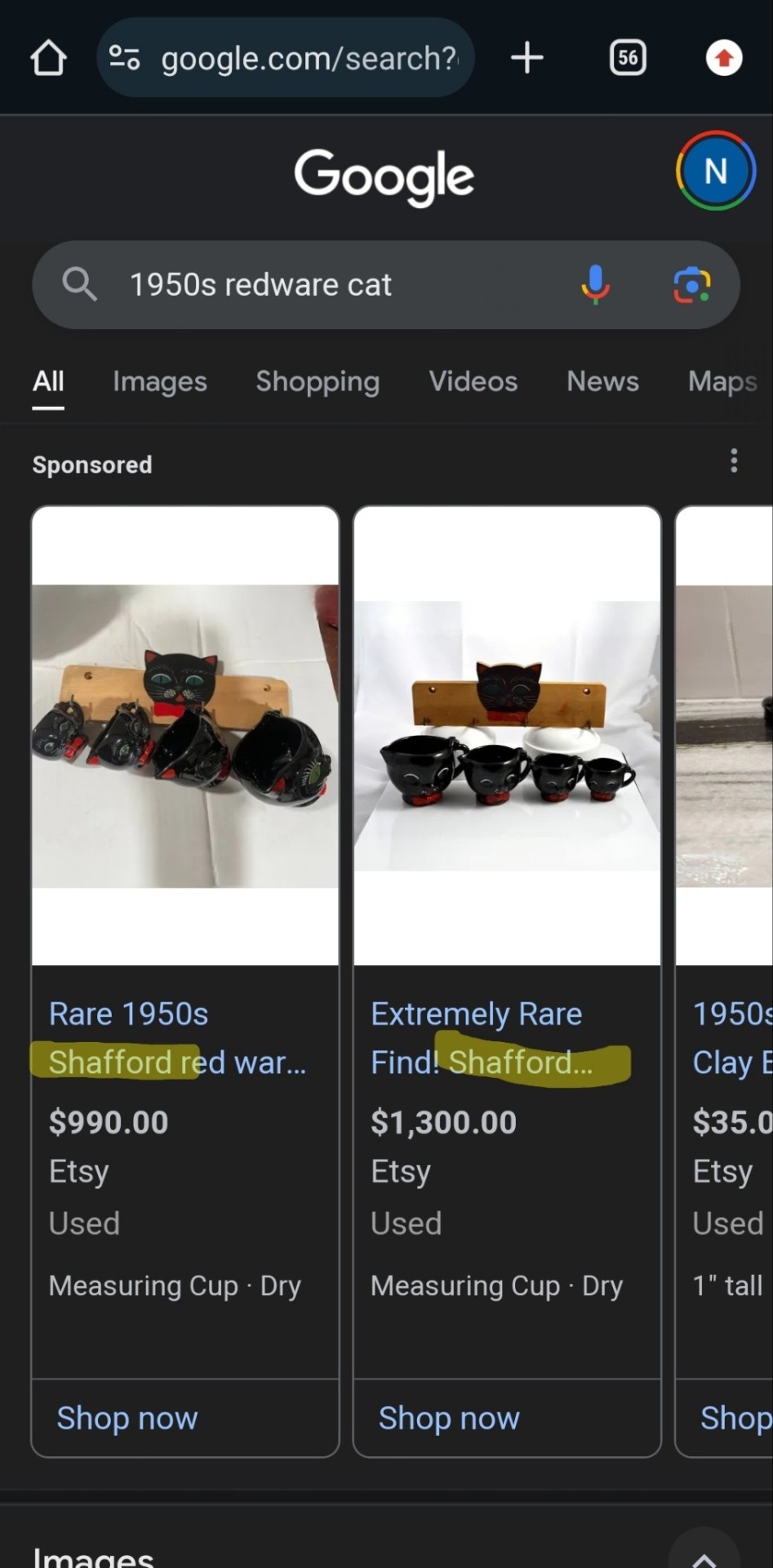
Oh! A maker name! "Shafford." This will make future searches easier. And look - there are other related cats - it looks like as various household items! (If you further researched the original cat, you'd also learn it is a tape measure and was made in Japan.)
Now, let's say you don't have a photo to start with, or just a vague idea of something you might want. Let's hop to Facebook marketplace and see if anyone is selling cute ceramic black cats.
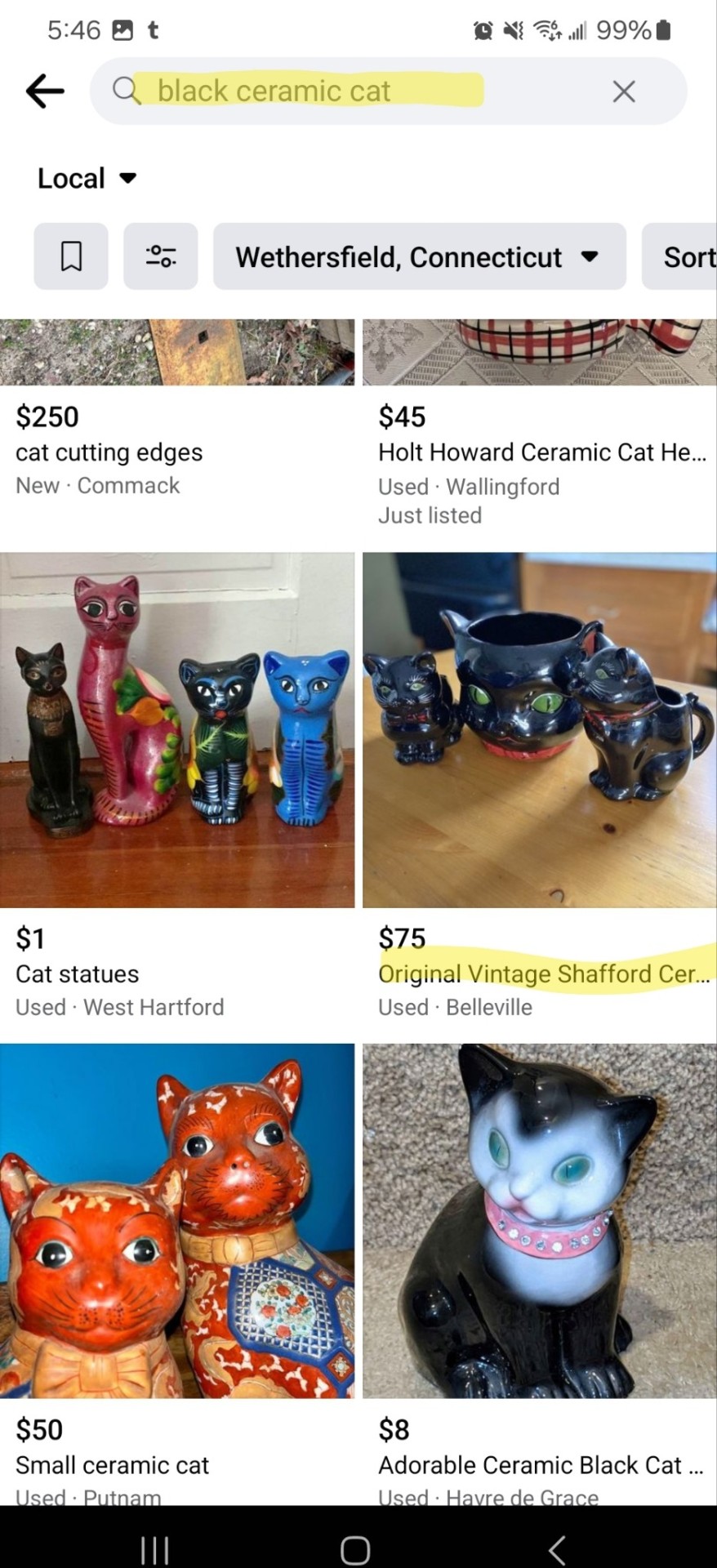
All of these results could go down their own research paths, but again, I'm using the example of the Shafford cats.
Armed with some knowledge, it takes just a few searches to find an impressive haul. Honestly, if that wasn't 5 hrs away from me, I'd buy that lot in a heartbeat, selling/gifting what I don't want.
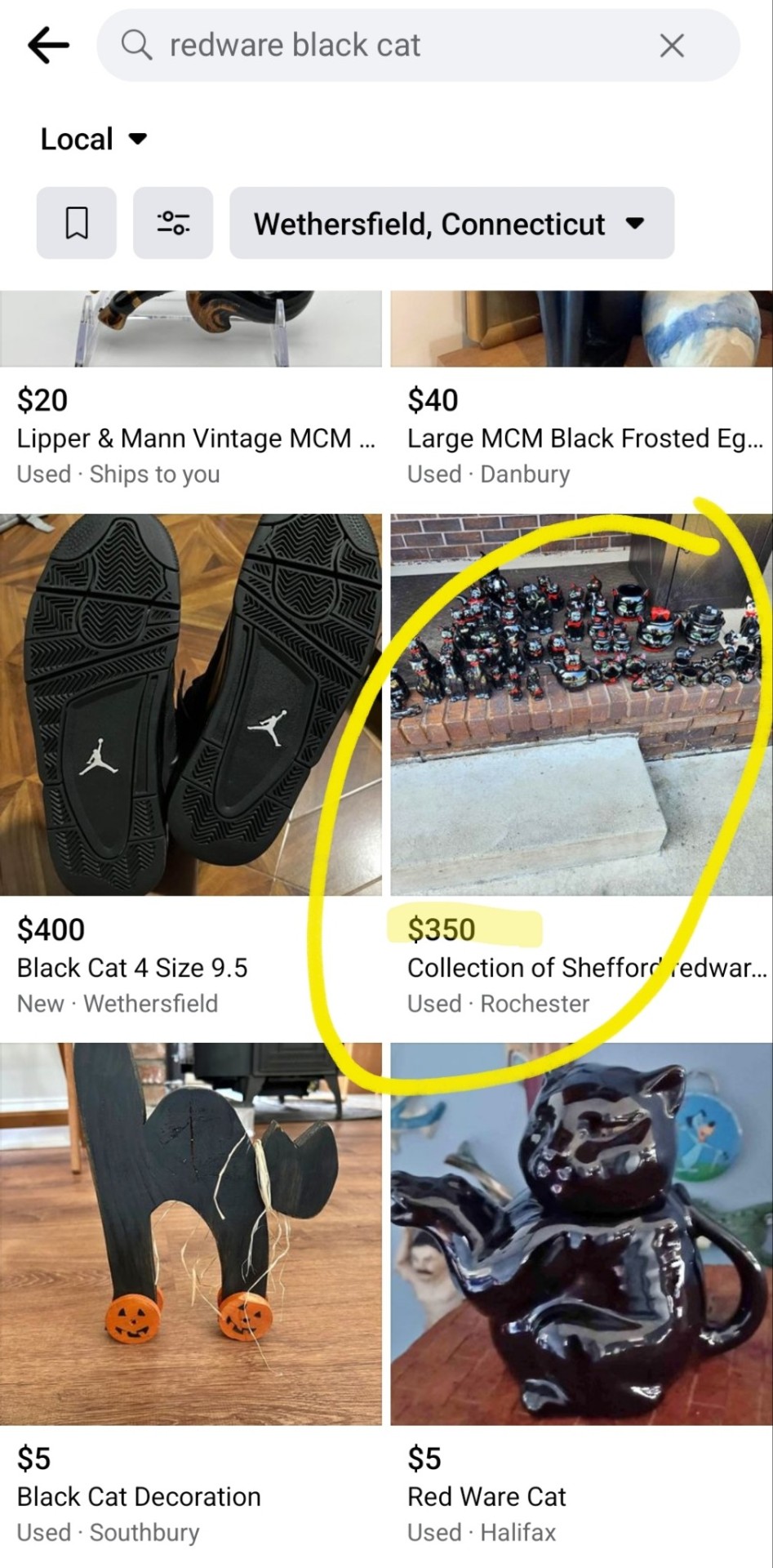
For future searches, you now have two paths:
Search for things using basic terminology to find sellers who aren't super knowledgeable. So, something like "vintage kitchen cabinet". You might luck out and find a seller who just wants the thing gone, they don't know its value, and it might be a steal for you!
Search again using the specific terms you have picked up from your research. So, "jelly cabinet." This will get you in front of listing from experts, where you are likely to find a better quality item at the current market price.
That is how I found this for my kitchen, btw.
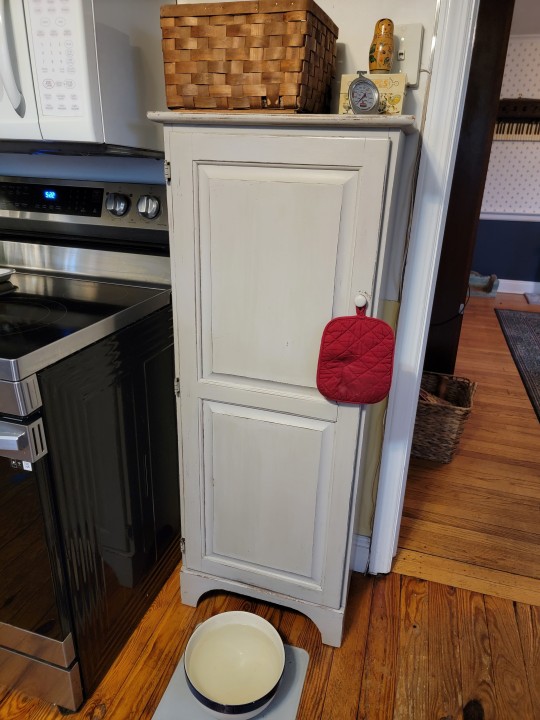
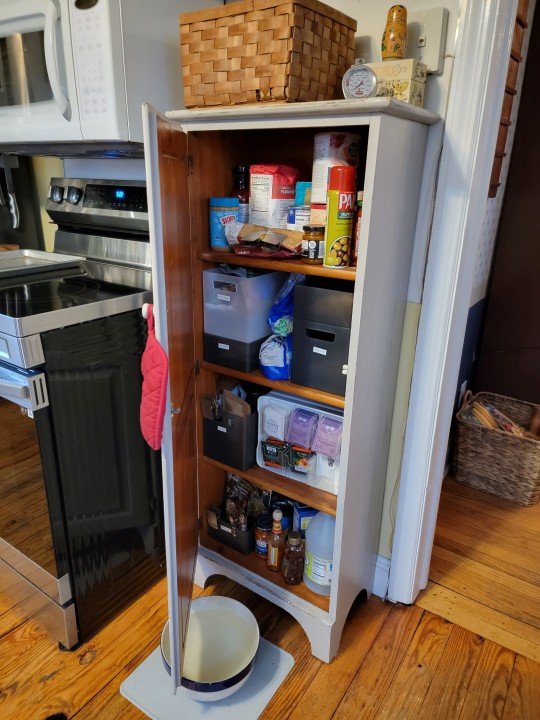
Learn the common synonyms and mispellings. Bookcase, bookshelf. Captain's desk, secretary desk.
Click on seller stores and profiles to see related items. As you research, you will start to stumble across other items and figure out your sense of taste. You will find cool shit you never knew existed. You will learn new search terms as you pick up bits of history. You will also start stumbling across online speciality sites, or local resources, like antique shops and vintage fairs. You might learn what estate sales are, or about auctions open to the public. You start developing a habit of scouting out shops and sales when you're in a new town. You put big fairs and small swap meets on your calendar. You build relationships with contemporary artists who make things you like.
My sense of style is something I've actively been refining for decades now, and it isn't just vintage tchotchkes. I do this for clothing, for the crafting I'm into, etc. Curiosity and style go hand in hand and the best part is that your eye and research chops will only improve, even if you're just window shopping.
I hope this helps!
86 notes
·
View notes
Text





A Taisho or early Showa houmongi, a type of semi-formal kimono. I love the long sleeves. I'm siding with early Showa. There's something about it that reminds me of 1930s tomesode that came from Ichiroya, who really went through a lot of effort to identify fine details of kimono. I appreciated it so much because I don't have any Japanese experts to ask and learn from.
The seller described it as "pure silk" but the lining feels synthetic to me. Too rough, even for rougher silk weaves. And the lining has a synthetic feeling. It's harder now, that the nerves in my hands are damaged and the fingertips especially are getting rough from hand-sewing and cleaning so often. I'm certainly no aristocratic person, that's for sure. A synthetic lining would have been a Good Thing at the time though, since I think they were less likely to have the colour bleed into the shell.
Collar style is bachi-eri, prefolded and sewn, no snaps or strings. Sleeves are so, so long, longer than most of the other kimono from the same era. I think today it would be considered chu-furisode length.
The fabric is shiny with a woven sayagata pattern overlaid with flowers that resemble daisies(?) and grasses. The yuzen patterns are three season: tachibana, bamboo, plum blossoms, chrysanthemums, maple leaves. Lots of fine gold painting which has somewhat flaked off.

There is a single mon which is embroidered, called 'nui mon.' The mon looks like kyuumaizasa, "nine bamboo leaves." (九枚笹) But I'm not sure because the centre does not have the leaf divisions.
Wrist to wrist: 50" Sleeve length: 29.25" Neck to hem: 61" Body width: 24.5"
There are some minor flaws but those are very typical for a kimono this age. The small sections where the silk is white, sometimes they have very tiny pale marks where the silk naturally turns brown, or there is subtle "bleeding" from the dye lines. It really doesn't trouble me at all. Instead, it shows authenticity.
This houmongi came from ebay seller Kimono Kyoto Ikkidou.
#japanese#japanese tradition#japanese culture#kimono#japanese kimono#showa kimono#taisho kimono#antique kimono#private collection
5 notes
·
View notes
Text
Agatha All Along: Gay teen and witch trapped in a bad tv-show world

Agatha All Along appeared without warning on my Disney Plus page, showing two elderly women and a teenager on a dark wilderness road. The teenager is Joe Locke, who played a gay character in Heartstopper, and came out in real life twice, at age 12 and 15, so no doubt he plays a gay character here. I'm not even going to bother with preliminary research.
Scene 1: An elderly woman, maybe Agatha, driving to a crime scene: she's a small town cop suspended for punching a suspect, but called back for a case only she can work on -- a woman has been found dead in the woods. Why is it always a woman, never a man?
Crushed by a heavy object, no id except for one of those old library check-out cards.
Scene 2:Wait -- her name is Agnes, not Agatha, so who is "all along"?
She goes to the library, where there's a long line to check out books. Have you been to a library lately? She cuts -- "Only suckers wait their turn" -- to ask the sarcastic librarian Miss Jones about the check-out card found on the victim.
Miss Jones: "Ooh, is she dead?"
Agnes: "Why do you assume it was a woman?" Because it's always a woman, nitwit.
Miss Jones: "It's more tit-ilating." Boob joke, har har.
They don't use old-fashioned check-out cards anymore. The book -- Dialogue and Rhetoric: Known History of Learning & Debate, was marked stolen three years ago. But there are lots of other copies in Natural Sciences. Not in English?.
Agnes hits the stacks, and there were indeed a dozen copies -- all burnt up. "There was a fire," a mysterious man whispers. Odd that Miss Jones didn't know that.
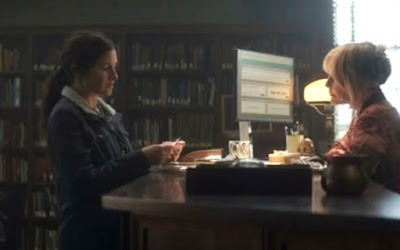
Scene 3: At the station, the Chief is played by David Lengel, who looks like Ross from Friends with a porn stash.
The body shows traces of "a particular microbial sediment found only in Eastern Europe." That makes no sense. The woman was killed across the ocean and transported to their quiet New England town.
Scene 4: In other news, Agnes has to work with the snarky Federal Agent Vidal, whom she hates. To be fair, Agnes hates everyone. They may be ex-lovers: Agnes thinks that she requested the assignment just so they could get back together.
Ex-Lover notes that there are no drag marks on the soil, nothing disturbed: the body just got zapped there, as if by magic!
Agnes scoffs."In stories about small-town murders, it's always about the hidden secrets of the townsfolk, so let's investigate those."
Scene 5: Norm the pawn shop guy, played by Asif Ali, is examining a cameo locket that Agnes brought in: New England, late 17th century, with a lock of hair inside. He offers $200.
She just wanted an expert opinion so she could sell it on ebay, har har. Agnes is rather a jerk, isn't she?
Scene 6: Late at night, Agnes is fiddling around at the station. She discovers that the first letters of the book's title spell DARKH. So?
Later, in her huge "TV middle class" house, Agnes goes into a child's bedroom with a teddy bear on the bed and drawings on the table, and music awards: "Nicholas Scratch, First Place." Dead kid? But Nick and Scratch are both names for the Devil.
Scene 7: Knock on the door: It's the Ex-Girlfriend, with pizza! Isn't it, like, the middle of the night?
Agnes has a lead: car crash in the town of Eastview an hour before the body was found. Ex-Girlfriend wants to know if she's ever been to Eastview. "Sure, I'm a world traveler." Wait...it dawns on Agnes that she's never actually left town. How is that possible?
Next Ex-Girlfriend asks "Do you remember why you hate me?" "No." It's like it was written into the script, with no back story. Something is wrong here.
They're interrupted by a clattering -- an intruder in her bedroom, going through her stuff! She chases him out onto the roof, down a gutter, and through the deserted streets, until Debra Jo Rupp, Grandma Kitty on That 90s Show, accidentally hits him.
Scene 8: The perp is a teenager, played by Joe Locke. He's sarcastic and insulting, leading Agnes to kick him -- that's what got you suspended, Girl. Finally he admits that he broke in to look for the Road.
Agnes thinks he means the road to the murder site, so he's a suspect! "What you were doing last night between 1 and 3 am?" "Asleep in bed." "Loser!" Wait -- being asleep in the middle of the night makes you a loser?
She pulls out pictures of the murdered woman to confront him with, but suddenly they turn into pictures of flowers on someone's front lawn! He starts chanting in Latin....and now her Ex-Girlfriend has vanished! There never was a murder, so of course she would not have been called in.
Scene 9: Agnes visits the coroner's office -- no body. Until one appears, with a check-out card instead of a toe-tag, and the last person who checked the book out was Wanda Maximoff! Agnes is shocked!
Who the heck is Wanda Maximoff? Answers and nekkid men after the break
Agnes figures out the truth, but the viewer won't without research. It's a slog, so here's a random photo of Mike Guzman to keep your spirits up.
Wanda Maximoff is the Scarlet Witch in the Marvel Cinematic Universe. In the earlier series Wandavision, powerful witch Agatha Harkness zapped her memory and trapped her in a small town sitcom world. Townsfolk played various characters, and she herself dropped in as the Wacky Next Door Neighbor.
At the end of the series, Wanda regained her memory, and for punishment, trapped Agatha in the small-town world, with her powers gone, forced to live through various badly-written tv show plotlines.
Ex-Girlfriend notes that Wanda is dead, and all of the copies of the magic book Darkhold went with her, so now there's no way out.
Scene 10: Uh-oh, the story is shifting. Agnes turns into a 1980s jiggle-show aerobics instructor, then a 1950s sitcom housewife, then a 1990s liberated woman -- ugh, she's naked. The former police chief, sarcastic librarian, and coworker Herb are now her neighbors. They say that she hasn't been herself for a few days, acting like a small town cop instead of a liberated woman.
She remembers that she is Agatha, but her magic powers are gone....
Muffled screams from upstairs -- it's the Teen, tied up in the closet. So in this plotline she kidnapped him.
Ex-Girlfriend appears to kill Agatha. They sexy-fight, the homoerotic tension dripping from every lick.
More research: Ex-Girlfriend is Rio Vidal, a former member of Agatha's coven, but Agatha found the Darkhold book and betrayed her, keeping all of the magic for herself. Now she's out for revenge.
Agatha suggests that it wouldn't be fun to kill her now, when she's lost her powers. Wait until she gets them back, to make the fight more interesting.
Ex-Girlfriend agrees, but warns Agatha that the Salem Seven also want her dead, and so...
She leaves. The Teen is still in the closet. The end.
Beefcake: None. This is a very-women centered show. The IMDB doesn't list the whole cast, so I had to sit through five minutes of executive producers to get a cast list. And that only lists five men: Joe Locke, David Payton, David Lengel, Asif Ali, and Amos Glick.
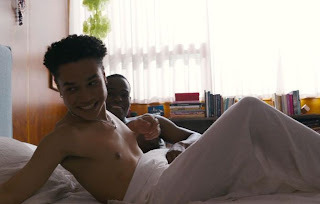
Gay Characters: Agatha and Vidal act very much like ex-lovers. The Teen turns out to be gay, and in a later episode he gets a boyfriend, played by Miles Gutierrez-Riley, left and below. Miles also played a gay character on The Wilds.
Heterosexism: None.
The full review, with nude photos, is on RG Beefcake and Boyfriends.
2 notes
·
View notes
Note
hi! love your blog sm <3 do you have any tips for shopping on ebay? all the choices/the UI can be a bit intimidating, but i'd love to learn how you whittle down all the options + find gems!
hiii thank you !! 🤍🤍 yeah the sheer amount of stuff on there can def be intimidating… idk that i have any really helpful advice other than to start your searches with something specific in mind, look for good lighting/lots of photos if possible, and only buy clothing w measurements?
also there’s a lot of drop shipping now, same with etsy, so be suspicious of photos that look professional/edited and take the time to browse through plenty of search results—if you see repeat photos from diff sellers it’s definitely drop shipped.
as far as ui goes, i find bidding to be super stressful so i don’t really do it if i can help it lol. i just hit buy now if it lets me 😅😅 but u can always message sellers with offers, a lot of the time people are just trying to get rid of stuff and not lose money on shipping !
i wouldn’t call myself an expert by any means, but i hope this helps at least a little :))))
9 notes
·
View notes
Text
Unlocking the Potential of 3D Printing: A Guide to PrintPrizm3D
Welcome to the world of 3D printing with PrintPrizm3D! Whether you’re a hobbyist, a small business owner, or an innovator looking to turn your ideas into reality, 3D printing offers limitless possibilities. At PrintPrizm3D, we specialize in providing high-quality 3D printing services that cater to a wide range of needs. Discover how our services can help you bring your visions to life and explore the benefits of incorporating 3D printing into your projects.
What is 3D Printing?
3D printing, also known as additive manufacturing, is a process of creating three-dimensional objects from a digital file. By layering materials such as plastic, metal, or resin, 3D printers can produce complex shapes and intricate designs with precision and accuracy. This technology has revolutionized industries, including aerospace, automotive, healthcare, and fashion, by offering rapid prototyping, custom manufacturing, and cost-effective production.
Why Choose PrintPrizm3D?
At PrintPrizm3D, we pride ourselves on delivering top-notch 3D printing services. Here’s why you should choose us for your next project:
High-Quality Prints: We use advanced 3D printers and materials to ensure your prints are of the highest quality. Whether you need a prototype, a functional part, or a decorative item, we’ve got you covered.
Expertise and Experience: Our team has extensive experience in 3D printing and design, enabling us to handle a variety of projects with skill and efficiency.
Customer Satisfaction: We are committed to providing exceptional customer service. From the initial consultation to the final product, we work closely with you to meet your specific needs and expectations.
Our Services
PrintPrizm3D offers a comprehensive range of 3D printing services to cater to various requirements:
Prototyping: Quickly and accurately create prototypes to test and refine your designs.
Custom Manufacturing: Produce custom parts and products tailored to your specifications.
Design Services: Our expert designers can help you create and optimize your 3D models for printing.
Educational Workshops: Learn about 3D printing technology and its applications through our informative workshops.
Visit Our Online Stores
Explore our wide range of 3D printed products and services on our online platforms:
PrintPrizm3D Website: PrintPrizm3D Website
PrintPrizm3D eBay Store: PrintPrizm3D eBay Store
Connect with Us on Social Media
Stay updated with our latest projects, promotions, and 3D printing tips by following us on social media:
Facebook: PrintPrizm3D Facebook Page
Instagram: PrintPrizm3D Instagram
Rippin-R-Us Instagram: Rippin-R-Us Instagram
Rippin-R-Us Facebook: Rippin-R-Us Facebook
Get in Touch
Have questions or need assistance with your 3D printing project? Contact us at [email protected]. We’re here to help you every step of the way!
Conclusion
3D printing is transforming the way we create and innovate. At PrintPrizm3D, we’re dedicated to providing high-quality 3D printing services that help you turn your ideas into reality. Visit our online stores, connect with us on social media, and discover how we can assist you with your next project. Embrace the future of manufacturing with PrintPrizm3D!
For further insights and tips on 3D printing, subscribe to our blog and stay tuned for more updates. Happy printing!
#ShopNow#OrderNow#BuyNow#LimitedEdition#NewArrival#3DPrinting#AdditiveManufacturing#3DPrint#3DPrintingCommunity#3DPrintingTechnology#3DPrinted#3DPrinter#3DPrintingService#Prototyping#ProductDesign#CustomManufacturing#RapidPrototyping#Engineering#ProductDevelopment#TechInnovation#eBayStore#eBayDeals#ShopOnEbay#EbayFinds#EbaySeller#FacebookMakers#3DPrintingFB#MakerSpace#Insta3DPrinting#3DPrintingArt
2 notes
·
View notes
Text
A Recording of a Lady
After catching the bug of collecting unusual oddities, you will gain the Eye, and inevitably come across a legitimate treasure. Not an earth shattering one necessarily but something that tells a more satisfyingly complete story than usual, and makes you relieved it wasn’t lost to time….and wonder why it isn’t at least in a local museum.
During my probably unhealthy phase of buying ameteur recordings on eBay and then filing them away, I found this lot. It consisted of an aluminum record, and your typical amateur record faire of the time, a recording of some kid’s christmas pageant from 1951. Alone this would be interesting but I already have one of these and the aluminum record caught my eye.
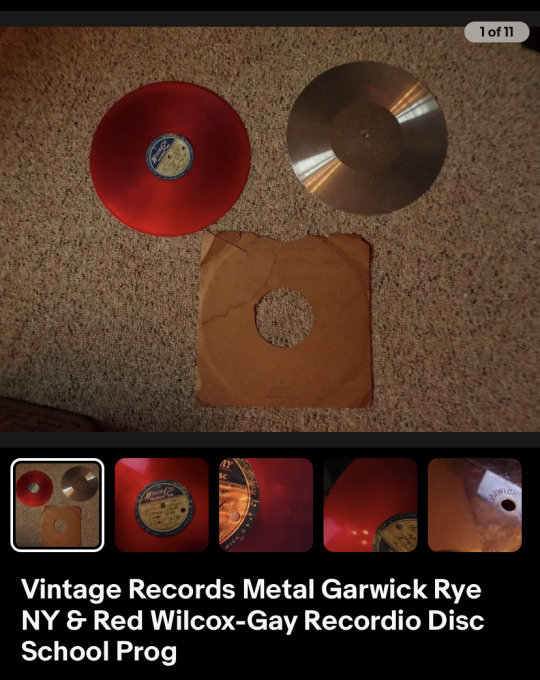
Aluminum records, particularly the Speak-O-Phone brand typically date from the 20’s and 30’s and were one of the few options available for the general public to hear themselves on their phonograph. With bamboo needles only of course as the steel needles would destroy your record.
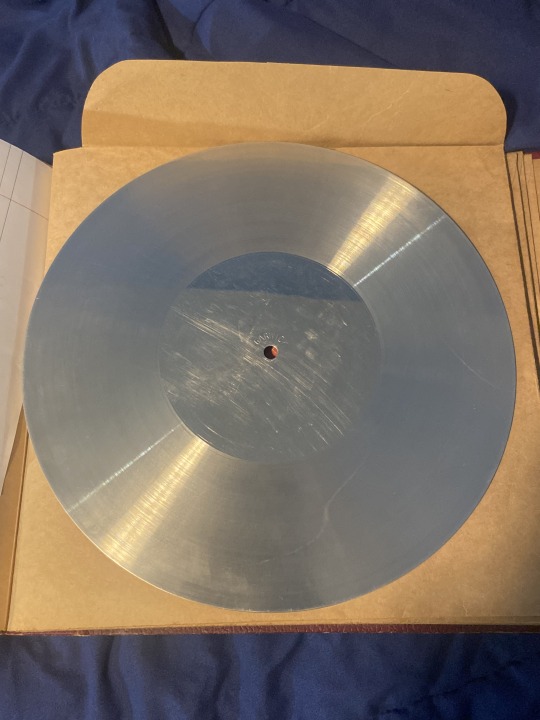
But this was not a Speak-O-Phone, this was a Walter C. Garwick, Rye NY record. Looking up this name revealed quite a bit. Walter C. Garwick was a recording engineer who built his own record recorders and recorded primarily for experts in the ethnomusicology field throughout the 30’s. He provided recording service for the America Dialect Society and ethnomusicologist Laura Boulton and designed a record lathe for the Library of Congress. His recordings are mostly held by the Library of Congress and Columbia University and at least a few more in private hands according to one worthpoint post. Here’s a good dive into Mr. Garwick’s life.
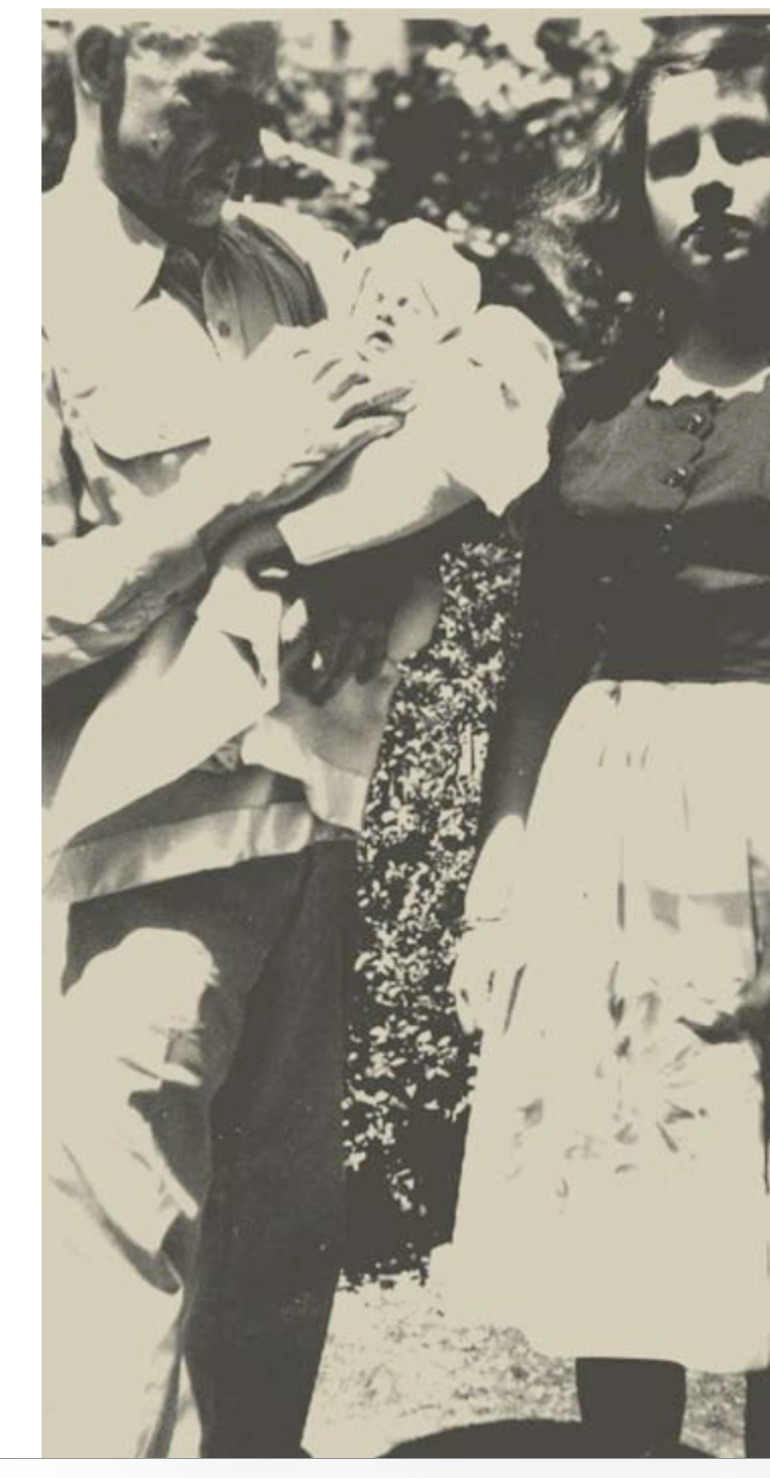
Walter C Garwick in 1945 holding a baby.
source: Christine Whittaker
I knew this had to be one of those so naturally I got it. I didn’t originally notice it but when it arrived I saw that the record sleeve has a note scrawled on it, providing more clues.

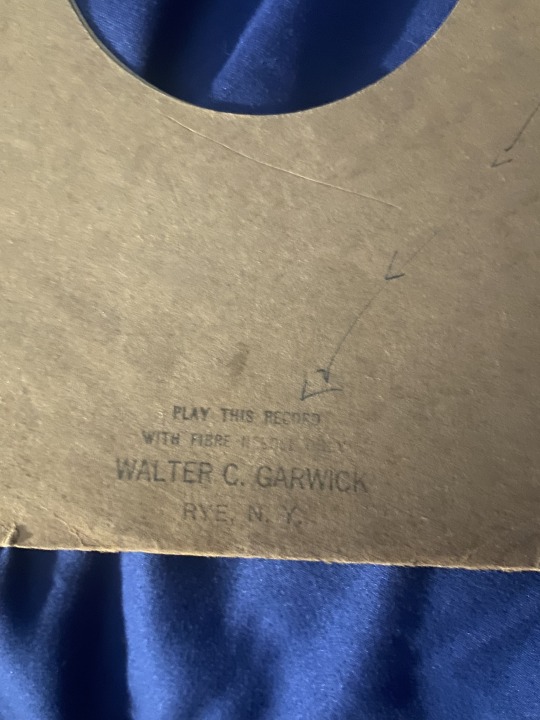

“The Little Half-Chick told by (a name starting with Cl) P. Cope.”
Below there’s a trail of multiple arrows leading the way to the reminder “Play this record with fiber needles only.” Whoever recorded this probably had a frustrating history of people ruining his records with their steel needles and needed MULTIPLE arrows for emphasis. This has got to be the real thing.
The recording features a woman, Ms. Cope, narrating the Little Half-Chick, the Spanish folktale of a flat chicken and how it became the weathervane.
The recording is noisy but her voice comes in very clearly in places. Towards the end a man, possibly a researcher or Mr. Garwick himself, asks “Who is telling this story?” which she responses with an unintelligible first name with her last name, Cope. The man then asks “Ms. Cope, what are you doing…” and then becomes unintelligible.
My next steps from here are to figure out whether the man‘s voice appears in other Garwick recordings and what Ms. Cope’s first name is. I can’t hear what she says and I can’t read the handwriting.
(I was part of the last 3rd grade that learned cursive before my school district splurged and gave us all iPads that everyone broke one week in.)
I could also look into whether physical documentation exists that this recording was made. This is easily my greatest find. Not only is it likely from the 30’s but it can be tied down to a name, and if I’m lucky, a date. I want to ensure its story gets told.
My time with it is probably temporary and as I poke further, I will likely end up donating it somewhere, perhaps joining its brethren at the Library of Congress, a family, or Columbia University.
Here is my recording of both sides on the top of the post. I heeded the warning by using a fiber needle and recorded it with my 1914 Victrola and an iPhone in the horn.
4 notes
·
View notes
Text
Creata "Hilary" joins the fam
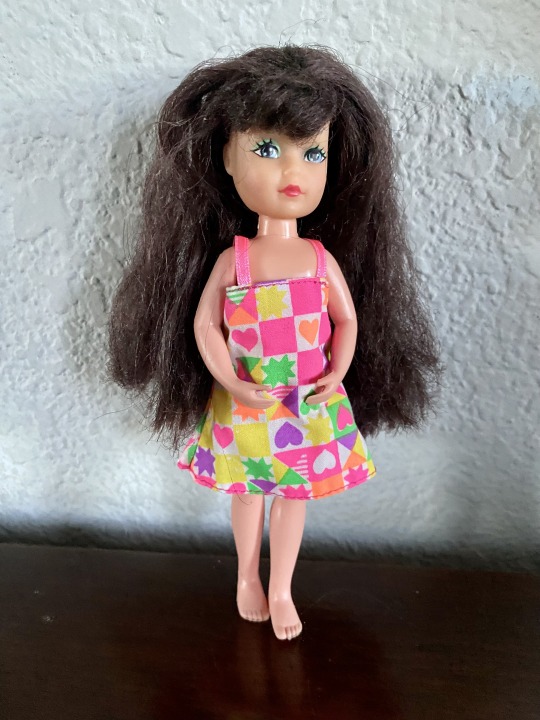
Here she is, after three boil washes with conditioner but before the next two boil washes with fabric softener. She has borrowed someone's dress.
A "can someone ID this doll" post on r/dolls got my attention when someone (not me) pointed out the existence of the 1980s clone brand Creata. Crystalline Toybox's guide to Creata dolls is extensive and fascinating. The appeal of the rocker line, we can all figure out, but why were flower princesses (with princes!) hot in the 1980s?
After wallowing in this for a bit, I went browsing eBay, just to see, and discovered that as well as the adult dolls, there were little girls, sort of Stacie-ish in size and function. BananaMom's haul video from 2019 confirms that there were a lot of these gals between 1987 and 1989, marketed as Today's Girls (with an S, because we're back before everything had to end in Z). There were Pony Gals, some sort of slumber party, and, according to the back of a box I found in an eBay listing, mini-flower princesses.
So I bookmarked a Today's Girl whose face I particularly liked, the seller made me an offer I couldn't refuse, and she arrived from Florida about a week later. Based on her shirt, it's plausible that she's Pony Gals "Hilary" (who came in multiple hair colors).

She arrived looking just as described. The seller's "just needs her hair combed" was technically true!
Her hair was a ratted mess. I pulled out a real comb from the dollar store, put on some YT videos, and started combing out small sections.
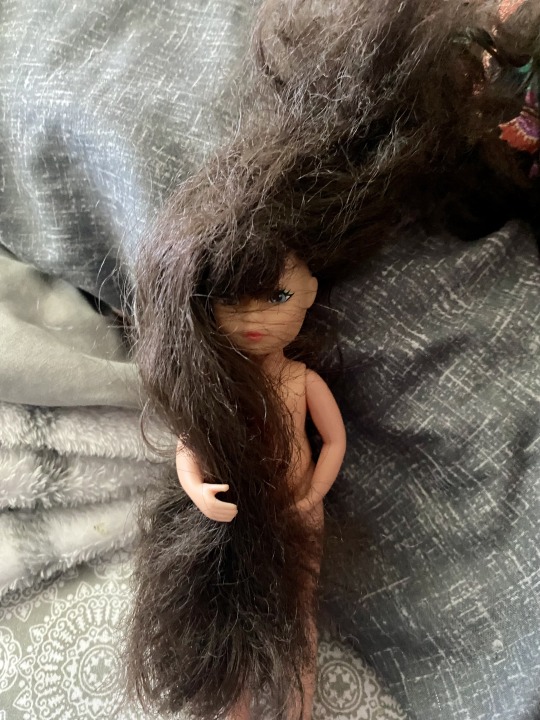
Over the course of 45 minutes, I learned about common mid-century housing types in LA, how to make donuts, how Chef Frank makes the perfect French toast, and that Epicurious' food experts tasting jarred tomato sauce are unaware of necessities of mass production such as machine-harvesting rather than strolling gently through the field, plucking each tomato at its individual peak of ripeness.
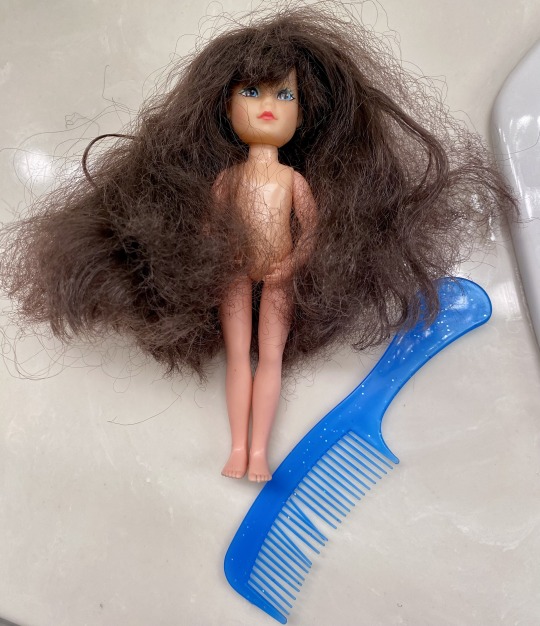
Here she is before her first of three boil washes that got her to the point seen in the first pic. I also trimmed her hair because the furthest ends were so damaged that all they did was catch on one another like Velcro.
Today I went to a different dollar store, got a small size of fabric softener, and gave her another two washes. I think the fabric softener helped, but her bangs still aren't quite-quite.

Hilary is about 6-1/4 inches tall, making her smaller than Whitney (who's from the early 1990s articulated Stacie line, thus 7.5") but much taller than Brooklyn, a 4" Sparkle Girlz Mini from the early 2010s.
Comparison of body types is after the cut.

Whitney obviously has a much more posable body.
Hilary can raise her arms to touch her face and can do front-to-back split, but that's about it.
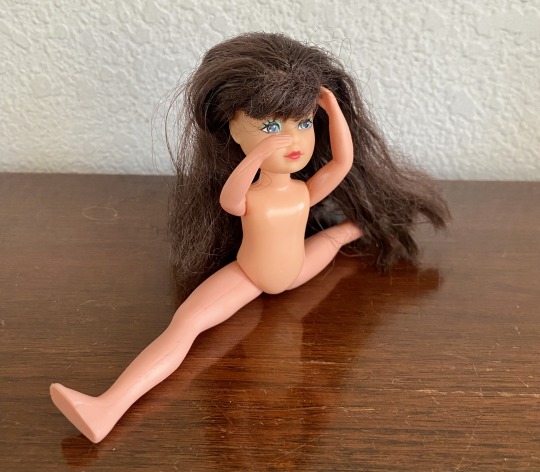
She cannot sit in any position other than legs splayed.

When I went to try Whitney's dress on her, I discovered that her hands are too big to fit through the sleeves. They are slightly larger than Whitney's, and her feet are almost as big!
This somehow didn't add up to my having any shoes that fit her. I'd be regretting donating my mother's huge collection of shoes except that I know she didn't have any dolls this size, so probably nothing would have fit.
While we're naked, here are Hilary's marks.
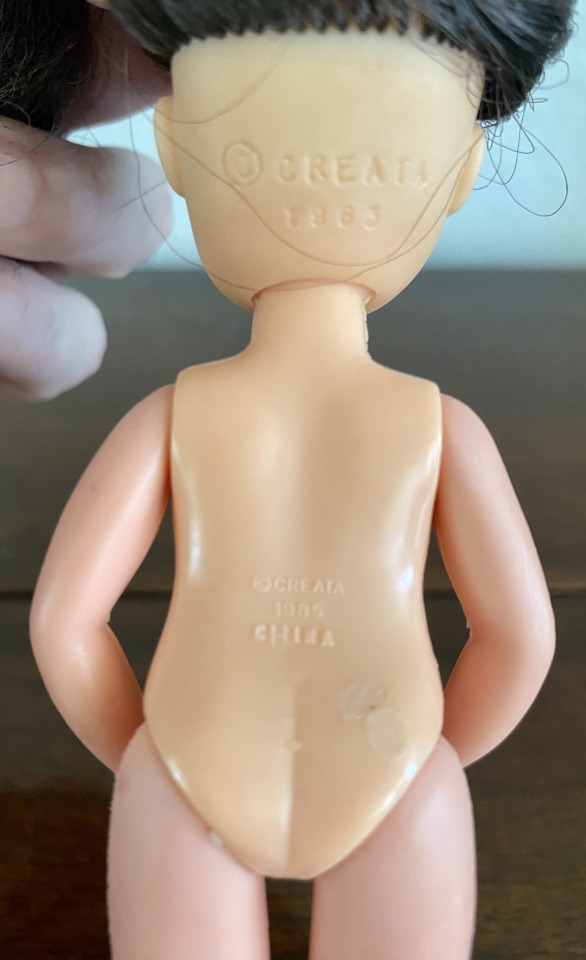
Hilary's head was copyright in 1983 and her body in 1985. Confusingly, the USPTO database shows Creata registering "Today's Girls" in 1991, even though BananasMom clearly shows boxes with late 1980s dates.
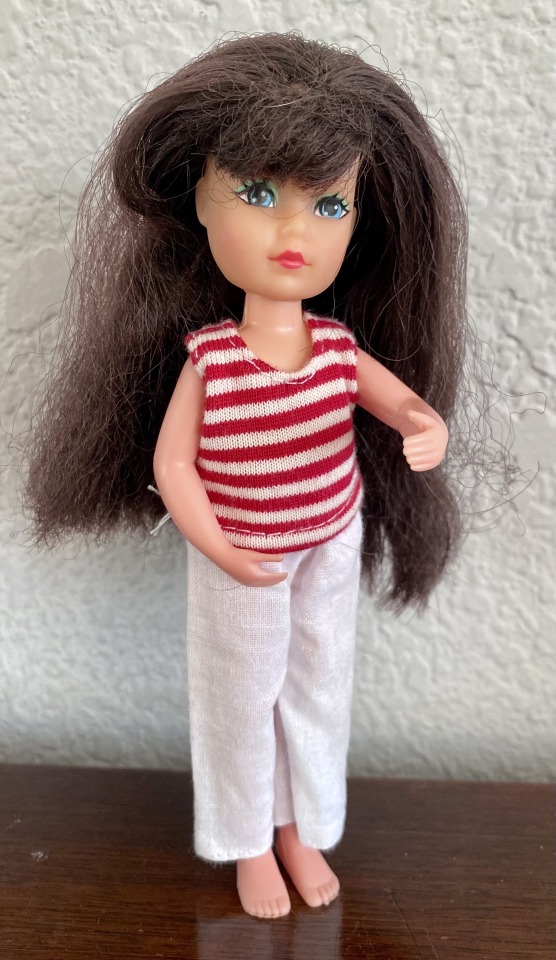
I found another outfit for Hilary, most likely Kelly clothes.

If you're wondering, why is a small child wearing bright lime eye shadow... just chalk it up to 1980s weirdness. More important is that her eyebrows have gone gray!
I may fix that with an eyebrow pencil eventually, but not until I'm sure I'm done trying to smooth her hair.
Meanwhile, Stacie, Whitney, Brooklyn, and Zuri are eager to get to know their new friend!

3 notes
·
View notes
Text
This is being considered as big data and NOSQL decade for software industry. Most of new software development is happening using NOSQL database. There are many NOSLQ Databases however MongoDB is the most popular choice due to being highly scalable open source & free NOSQL database option. Many high volume web applications and mobile applications are designed using MongoDB as a backend database. In this article we are going to cover all high level details you need to know about MongoDB and its usage. You may also want to check some good MongoDB books to learn and become a Mongo DB expert. Everlasting Popularity of MongoDB Explained Traditional databases have long been built on a singular architecture of Database -> Table -> Row/column -> table join. This led to expressive query-based languages (such as MySQL), uniformity, and facility for secondary indexes. However it lacks on a few crucial fronts – factors that can drive the success of your application or website. The interesting thing about MongoDB is that, as against traditional table structure in relational databases, MongoDB uses dynamic schemas (BSON). This ensures a more agile, nimble, and fast database - a much needed trait in today’s technology landscape where data is huge, time is short, risk is bigger, and cost needs to shrink every time. History of MongoDB The company, MongoDB Inc, first rolled out the service in October 2007 as a small component of a product platform. But within 2 years, it was transitioned to open source development approach. Ever since, it continues to be embraced by scores of websites and applications as a preferred backend software. What is MongoDB? Developed over C++, MongoDB is a wildly popular open source NoSQL database. Its cross-platform architecture provides immense utility and versatility to programmers who want to make us of a document oriented open source database. Mongo DB Popularity on Google Search Below is a snapshot of google search trends that show popularity of MongoDB has been growing in past few years. Why is MongoDB So Popular? It is not for no reason that business behemoths like eBay, Craigslist, or Foursquare depend on MongoDB. There are many compelling success factors that ensure that MongoDB continues to enjoy top billing as the world’s fourth most loved database. Let’s look at some of these – Huge volume of data? Bring it on! Imagine having millions of records to be stored, accessed, processed or shared in real time. With Big Data throwing curve balls every single day, MongoDB is the one database that can handle such large data with absolute ease. One practical example we see is Craigslist that uses MongoDB as a backend. It sees about 80-82 million advertising classifieds posted every month from across 70 countries. As such, its repositories gets populated pretty quickly. MongoDB not only handles this sheer size of data, but also helps in timely archiving and access to data across 700 different sites. Schema less architecture and sharding Because of its document based architecture, MongoDB features one collection (just like a table). This scale-out architecture adds value at multiple levels over the monolithic architecture of MySQL. It also helps to be better aligned with OOP principles. When it comes to load balancing, MongoDB uses horizontal scaling with help of sharding (storing data on multiple machines for efficient usage). You can add machines to balance your load needs and prevent any overload on a single machine. With sharding comes the issue of synchronization – something that is actually a non-issue, with the powerful replication facility provided by MongoDB. Replication helps redundancy and improves availability of the most up to date data. The combination of sharding and replication also comes in handy when recovering from a catastrophic IT failure or interruptions in services. Quick to set up and deployment MongoDB presents a very quick setup and deployment time. This not only helps client business to ramp up faster, but also helps them delight their customers with their agility and speed.
A good example is Forbes, which used MongoDB to come up with a simultaneous web CMS and mobile site. While the web CMS came up in two months only, the mobile site was ready in just 30 days. Better for your business Taking the above example of Forbes website, the publishing company took up the step of overhauling their content management systems. When the mobile site and website CMS came up, it managed to create a lasting impression on the minds of its users – prime being the fast access and speedy content delivery facility. As a result (to quote MongoDB’s words) “Overnight, mobile traffic jumped from 5% to 15% of Forbes.com total traffic, and quickly ramped to 50%”. In addition to the revenue increase, it also helped cut down on cost overheads by keeping just one full time and one part time IT person for the mobile website. High Performance Persistent data is handled smartly by MongoDB, thus leading to a high performance backend. It enables this in two distinct ways Embedding data in single structure. The schema is known as ‘denormalized’ model and is successful because of the BSON enabled document-like structure. Because of this, the I/O operations on the database system is reduced dramatically, leading to faster working backend. Using the ‘ensureIndex’ function, a field being indexed will return a result at just 8%-10% of the time taken for querying and searching every document in a collection of the MongoDB database. This is a vital time saving advantage. Indexing also provides the facility to include keys from embedded objects or arrays. Why Pick MongoDB? As is evident, express setup, huge data handling capacity, and horizontal scaling ability, are three key advantages that work highly in favor of MongoDB. This makes it an apt open source backend system to use for today’s times where content management delivery, data hubs, social media, big data, cloud computing, and mobility, have generated colossal volume of dynamic data. Where can we use MongoDB? If your data is too complex to be queries on a relational database If there are high occurrences of denormalizing the database schema If there are high occurrences of programming involved to tweak performance If your inputs are in form of BSON documents or serialized arrays If you want to store documents irrespective of the relation If pre-defining the schema or structure is not possible Where should we NOT use MongoDB? If you need ACID compliance then MongoDB will not be a right choice. Also because of inherent limitations associated with a 32-bit system, MongoDB doesn’t perform well here, and instead recommends a 64-bit architecture. To sign off MongoDB has proven its mettle handling incredibly huge data. With its schema less architecture and zero relational dependency, it has sustained at a leadership position as a NoSQL database of choice for today’s companies who want to surge ahead of competition with fast, agile and scalable application and websites. Harry is a web industry specialist having keen interest in reading novels and writing tech blogs on diverse topics.Currently, He is associated with Techiesindiainc, specializing in offshore web development and iOS development services.Techiesindiainc has more than 200 international clients who outsource Website Design And Development projects along with various other IT requirements.
0 notes
Text
From Raw to Remarkable: A Day in Our Editing Workflow

In the fast-paced world of eCommerce, photography isn't just about capturing moments—it's about presenting products with precision, clarity, and style.
At Clipping Way, we turn raw images into market-ready masterpieces that help businesses grow and brands shine.
Our detailed, professional image clipping path service is designed to make your visuals not only stand out—but sell.
Whether you're a photographer, business owner, or Amazon seller, you've probably wondered: How to Resize Image for Amazon?
That’s just one of the many essential edits our expert team handles daily.
Join us behind the scenes for a closer look at how we transform raw files into remarkable, polished results that meet your platform's every requirement.
Step 1: Client Onboarding & Understanding Requirements
Every successful project begins with a clear understanding of the client’s vision. When you reach out to Clipping Way, you’re not treated as just another ticket in the system.
We talk directly with you to learn about your project goals—whether it's background removal, shadow creation, product retouching, or ghost mannequin service.
We offer a Free Trial and an easy Get Quotation process so you can evaluate our quality and price before making a decision. Our pricing is among the lowest in the industry, without compromising quality.
Step 2: Image Sorting & Categorization
Once your images are received, they are reviewed and categorized based on their complexity and required services. For example:
Simple (e.g., a single product on a plain background)
Medium (e.g., multiple objects, some intricate edges)
Complex (e.g., hair masking, jewelry, detailed patterns)
This sorting ensures we assign the right experts to your job and complete it in a timely manner.
Step 3: Precise Clipping Path Creation
Our trained graphic designers use Adobe Photoshop’s Pen Tool to hand-draw accurate clipping paths. We never rely on auto-selection tools, which often miss fine details.
Instead, we ensure clean, professional cutouts with sharp edges—perfect for eCommerce platforms like Amazon, eBay, and Shopify.
Clipping paths are foundational to everything we do—whether we’re removing backgrounds, creating a white backdrop, or preparing files for multi-channel selling.
Step 4: Retouching and Enhancement
After paths are created, our editing team dives into the creative and corrective retouching process.
We remove dust, scratches, wrinkles, and other distractions while maintaining the product’s natural look.
Color corrections are applied as needed to match brand requirements or product authenticity.
We also handle specific tasks such as:
Shadow Creation (natural, drop, or reflection)
Ghost Mannequin Editing
Color Matching and Swapping
Image Resizing for Amazon, Shopify, Etsy, and more
Step 5: Quality Check and Revision
Before delivery, every image undergoes a multi-level quality control process.
Senior editors review the files to ensure paths are tight, edges are smooth, and output matches the original brief. If any tweaks are needed, revisions are done instantly to avoid delays.
At Clipping Way, client satisfaction isn’t optional—it’s guaranteed.
Step 6: Fast, Secure Delivery
We offer multiple delivery formats including PSD, PNG, TIFF, and JPEG. Depending on your preference, we deliver via Google Drive, Dropbox, FTP, or email.
Turnaround times are as fast as 6 hours for urgent orders, thanks to our global team working around the clock.
Why Choose Clipping Way?
Free Trial Available – Test before you trust.
Lowest Price Guaranteed – Starting as low as $0.29 per image.
24/7 Customer Support – We’re here when you need us.
Quick Turnaround – Get images back in 6–24 hours.
100% Manual Editing – No auto-clipping or lazy edits.
We don’t just edit images—we elevate them to professional standards that drive results.

Frequently Asked Questions
1. How long does it take to receive my edited images?
A: We typically deliver within 6 to 24 hours depending on project size and complexity. Rush delivery is available for urgent needs.
2. Is there a limit to the Free Trial offer?
A: You can send up to 2 images for your Free Trial. It’s our way of showing what we can do—no strings attached.
3. Can I request specific file formats for my images?
A: Yes, we deliver in the format of your choice: PNG, PSD, TIFF, or JPEG.
4. What if I'm not satisfied with the editing?
A: We offer free revisions. If you're not satisfied, just let us know—we’ll make it right.
5. Do you provide bulk discounts?
A: Absolutely! We offer special pricing for photographers, studios, and eCommerce businesses that process large volumes regularly.
Conclusion
From the moment we receive your raw images to the final polished output, Clipping Way ensures every pixel is perfect.
Our meticulous editing workflow is built on quality, speed, and affordability—backed by a human touch that machines simply can’t replicate.
So whether you're selling on Amazon, designing a catalog, or showcasing your product online, let us handle the edits while you focus on scaling your business.
0 notes
Text
What is Multiple Clipping Path? A Game-Changer for E-Commerce & Creative Industries

Not too long ago, we found ourselves overwhelmed with editing hundreds of product images for a client’s new seasonal catalog. Each item came in multiple colors, different textures, and unique shadows. Simple background removal wasn’t cutting it anymore. We needed a precise, layer-by-layer approach. That’s when we turned to a multiple clipping path service and it changed everything.
Whether you're selling on Amazon, eBay, Etsy, or Shopify, or running a creative studio, you’ve likely encountered a similar pain point. Let’s talk about what multiple clipping path is, why it matters, and how you can make it work for your business.
What is Multiple Clipping Path?
Multiple clipping path is an advanced version of the standard clipping path technique used in photo editing. Instead of isolating a subject from its background with a single vector path, this method involves creating multiple paths for different parts of an image — think hair, body, shoes, accessories, shadows, and even individual color zones.
Short Answer: Multiple clipping path means creating individual paths for each object or color in an image to allow detailed editing, recoloring, or separation.
This technique is essential when you need to change colors, adjust shadows, or retouch specific parts of an image without affecting others. It's like having a Photoshop Swiss Army knife in your toolkit.
Step-by-Step: How Does Multiple Clipping Path Work?
1. Importing the Image
The process starts with importing your image into Adobe Photoshop. High-resolution images are ideal to capture every detail.
2. Creating Individual Paths
Using the Pen Tool, the editor draws precise paths around different elements — one for the sleeve, one for the collar, one for the buttons, and so on.
Answer-first: The image is broken down into segments using the Pen Tool to allow independent editing of each part.
3. Layer Separation
Each path is assigned to a new layer. This makes it easy to apply effects like color correction or contrast adjustments to specific sections without disturbing the rest.
4. Grouping for Efficiency
Related paths (e.g., all accessories) are grouped to streamline batch editing — perfect for e-commerce product catalogs with hundreds of SKUs.
5. Export in Desired Format
Once editing is done, the final image can be exported in formats like PSD, TIFF, or PNG based on your platform requirements.
Why E-Commerce and Creative Businesses Rely on It
If you're in fashion, real estate, photography, printing, or digital marketing, then you know every pixel counts.
E-Commerce Brands use multiple clipping paths to showcase each variant of a product.
Real Estate Photographers rely on it for color correction and shadow manipulation in interior shots.
Wedding and Event Photographers separate layers to retouch dresses, flowers, and backgrounds independently.
Social Media Influencers need it for cohesive, professional image layouts on Instagram and YouTube thumbnails.
Snippet-ready: Multiple clipping path ensures cleaner edits, accurate recoloring, and faster image turnaround times for professional use.
Expert Tips to Get the Perfect Handmade Multiple Clipping Path
From our experience, quality always beats speed when it comes to clipping paths. Here's what we’ve learned:
1. Insist on Manual Work
Automated tools often leave jagged edges and inconsistent paths. Always choose manual, hand-drawn clipping paths for cleaner results.
2. Provide Clear Instructions
Tell your editing partner exactly what you need — which parts to separate, any color changes, and desired file formats.
3. Zoom In and Review
Request layered files and inspect each path at 200-300% zoom. This helps catch any sloppy outlines or missed areas.
4. Ask for Sample Work First
Before you send a large batch, test the provider with 2-3 sample images.
Expert Tip: Handmade clipping paths are more accurate and flexible, especially when dealing with fine details like hair, fur, or jewelry.
When to Choose These Top Providers: Our Experience
We’ve worked with several clipping path services over the years. Here’s a breakdown of five popular platforms and when to use them:
1. ExpertClipping.com
The go-to for high-volume e-commerce editing. Their turnaround is fast, and the quality is consistent. We’ve used them for fashion catalogs, and they handle color variants and shadows flawlessly.
2. Path Edits
Perfect for advertising agencies and photographers needing more nuanced edits like shadow creation and background enhancement. Great customer service and flexibility.
3. Clipping Path Service
Best for real estate and architecture clients. They specialize in brightness correction, exposure balancing, and edge refinement. Excellent for interior image enhancement.
4. Offshore Clipping
We recommend them for budget-conscious small businesses. Decent quality for the price, especially for simple clipping path jobs and POD (Print on Demand) content.
5. UK Clipping Path
Ideal for European businesses looking for region-based support and GDPR compliance. We’ve had solid experiences using them for beauty and cosmetics brand editing.
Best Practice: Match the provider to your specific needs. High-volume edits? Go with ExpertClipping. Need creative retouching? Try PathEdits.
Final Thoughts: Why Multiple Clipping Path Is No Longer Optional
In today’s visual-first marketing world, image precision drives conversions. Whether you're styling a model shoot, listing real estate, or creating print merch, multiple clipping path services ensure your visuals are clean, color-accurate, and compelling.
Think of it this way: a standard clipping path is like wearing ready-made clothes, but multiple clipping path is bespoke tailoring — designed to fit your exact needs.
Company Information:
Website: https://www.expertclipping.com/
Facebook: https://www.facebook.com/expertclipping
Contact : https://www.expertclipping.com/contact/
Resources: https://www.expertclipping.com/blog/
Youtube: https://www.youtube.com/c/Expertclipping-ec
Twitter: https://twitter.com/expertclipping
Quote: https://www.expertclipping.com/free-quote/
Office Address
UK OFFICE
24 Longbridge Road
Barking Essex IG118tnv
www.expertclipping.co.uk
Phone: 02036093822
24 Longbridge Road
Barking Essex IG118tnv.
E-mail: [email protected]
Phone: +44 02036093822
ITALY OFFICE
168 Belaws, 4th Floor
Via Tolpada 21, 11400
www.expertclipping.com
0 notes
Text
Vintage Shopping: Finding Hidden Gems
Vintage shopping has evolved from a niche interest to a celebrated approach to fashion, attracting everyone from dedicated collectors to everyday style enthusiasts. It offers something that fast fashion can’t replicate—character, history, and authenticity. Whether you're browsing for a perfectly worn leather jacket, a retro handbag, or a designer dress from decades past, vintage pieces allow you to express individuality and sustainability in equal measure.
Beyond their aesthetic appeal, vintage items carry stories that are often deeply personal and meaningful. Each garment has lived a life before it reaches your hands, making your wardrobe feel more personal and curated. For many, the thrill lies in the hunt—never knowing what rare find might be waiting on the next rack.
Why Vintage Over New?
Vintage shopping offers advantages that extend beyond style. First and foremost is quality. Many older pieces were constructed during a time when craftsmanship was held to a higher standard. Materials like wool, silk, and genuine leather were more commonly used, and garments were built to last—not to be discarded after a season.
Sustainability is another primary reason vintage is on the rise. The fashion industry is one of the most polluting industries in the world, and choosing vintage helps reduce waste by extending the life cycle of garments. It’s a small but impactful way to practice more eco-conscious consumption.
Additionally, shopping vintage helps you avoid the fashion echo chamber. Instead of buying what everyone else is wearing from the same chain stores, you’re adding one-of-a-kind pieces to your wardrobe. Vintage lets you celebrate your uniqueness and stand out.
Where to Start Your Vintage Journey
The world of vintage shopping can be overwhelming at first, especially if you're not sure where to begin. Thrift stores are a great starting point. While they often mix modern and vintage pieces, with patience, you can uncover incredible finds. Estate sales and flea markets also offer hidden treasures, sometimes at bargain prices.
For a more curated experience, consider vintage boutiques. While items here may be priced higher, they’re typically well-selected, cleaned, and organized by era or style. Online platforms like Etsy, Depop, and eBay also host a wide range of vintage items, allowing you to shop globally from the comfort of your home.
Each shopping environment requires a different strategy, but they all share one thing in common—the need for an open mind and a willingness to dig.
How to Identify a True Vintage Piece
Learning to spot authentic vintage takes time, but there are key indicators that can guide you. One of the first signs is the label. Older garments often feature brand tags with outdated fonts, “Made in U.S.A.” stamps, or union labels. If you're unsure, a quick online search of the brand and label style can often help you determine the garment's era.
Construction details are another giveaway. Vintage clothing often uses metal zippers instead of plastic, pinked seams instead of overlocked ones, and hand-stitched hems or darts. The fabric itself may feel heavier or more durable than modern equivalents.
Don’t be discouraged if you’re not an expert right away. The more time you spend vintage shopping, the more familiar you’ll become with the nuances that separate authentic pieces from retro-inspired replicas.
Tips for Successful Vintage Shopping
Patience is your best friend when vintage shopping. Unlike retail stores where sizes and styles are consistent, vintage shops require browsing. Plan for extra time and wear comfortable clothes that allow you to try things on quickly.
It’s also important to keep an open mind. You may walk in looking for one thing and leave with something entirely different. That’s part of the magic—letting the pieces speak to you rather than sticking to a strict shopping list.
Know your measurements. Vintage sizing often differs significantly from today’s standards. Instead of relying on the size tag, bring a tape measure or ask for garment measurements, especially when shopping online.
Finally, scrutinize each item. Look for stains, holes, or fading. Some flaws are fixable, but others may affect wearability. Inspect seams, linings, buttons, and closures to ensure the item is worth the investment.
Tailoring and Care for Vintage Clothing
Once you've found a vintage gem, taking care of it ensures it lasts for years to come. Washing instructions may not exist or may not apply to today’s machines, so when in doubt, hand wash or take the item to a professional cleaner who understands delicate garments.
Tailoring can also make a big difference. A few simple adjustments—shortening a hem, taking in the waist, or replacing buttons—can transform a good piece into a great one. Since vintage clothing is often made with a wider seam allowance than modern clothes, there is usually room to customize the fit.
Store your vintage items properly. Use padded hangers for delicate blouses or dresses, and avoid overcrowding your closet. For knits or heavy garments, fold them carefully to prevent stretching.
Creating a Signature Look with Vintage
The beauty of vintage is its ability to enhance your style. You can go full retro with head-to-toe pieces from a specific era or mix vintage and modern for a look that’s uniquely yours. Pair a '70s suede skirt with a contemporary blouse or a '50s handbag with modern denim—there are no rules, just balance.
Accessories are a simple way to incorporate vintage into your wardrobe without making a significant change. Vintage scarves, belts, sunglasses, and jewelry add character and flair to even the most basic outfits.
Fashion should be fun, and vintage gives you endless possibilities to explore and redefine your look over time.
Vintage shopping isn’t just about buying old clothes—it’s about discovering pieces with soul, embracing sustainable choices, and expressing yourself with originality. Each hidden gem you find becomes a part of your story, adding depth and uniqueness to your style.
Whether you’re hunting through thrift store racks, browsing online listings, or exploring vintage markets in a new city, the experience is as rewarding as the clothes themselves. With the right mindset and a little practice, you’ll find that vintage shopping opens the door to a more prosperous, more meaningful way to engage with fashion—one that looks backward to move your style forward.
0 notes
Text






A Taisho or early Showa houmongi, a type of semi-formal kimono. I love the long sleeves. I'm siding with late Taisho based on pure feeling. A lot of aesthetics between periods are fuzzy to me. Ichiroya, who really went through a lot of effort to identify fine details of kimono, probably would have known. I appreciated it so much because I don't have any Japanese experts to ask and learn from.
The seller described it as "pure silk" but the lining feels synthetic to me. Too rough, even for rougher silk weaves. And the lining has a synthetic feeling. It's harder now, that the nerves in my hands are damaged and the fingertips especially are getting rough from hand-sewing and cleaning so often. I'm certainly no aristocratic person, that's for sure. A synthetic lining would have been a Good Thing at the time though, since I think they were less likely to have the colour bleed into the shell. This is a red momi (lining) which had not been replaced with white cotton, like so many were.
Collar style is bachi-eri, prefolded and sewn, no snaps or strings. There is a mark along the back of the neck on the inside. Sleeves are so, so long, longer than most of the other kimono from the same era. I think today it would be considered chu-furisode length.
The fabric is shiny and has a very textured weave, which dulls the 'shine' somewhat. The patterns are fans and himo. The yuzen patterns are three season: tachibana, two types of bamboo, susuki, camellia, yellow and white plum blossoms, those daisy-like flowers that I really should look up because they were super-popular then, and more open fans. Lots of fine gold painting which has somewhat flaked off and subtle embroidery on many fine details.

The crest matches the one on the purple haori I bought recently. This one is an extremely common pattern called gosan-kiri. It it very lightly embroidered, a nui mon, in single-thread embroidery. A very pale, light pattern, not the "full shadow"-style embroidered nui mon on another houmongi I have. There were once SO many 'shades' of formality. I suppose kamon were like kimono; you could make them however you liked, within certain rules, to create a message.
Wrist to wrist: 48" Sleeve length: 27.25" Neck to hem: 58.5" Body width: 23"
There are some minor flaws but those are very typical for a kimono this age. The small sections where the silk is white, sometimes they have very tiny pale marks where the silk naturally turns brown, or there is a single spot inside the lining where it looks like a drop of something splashed. It really doesn’t trouble me at all. Instead, it shows authenticity.
This houmongi came from ebay seller Kimono Kyoto Ikkidou.
#japanese#kimono#japanese tradition#taisho kimono#antique kimono#private collection#japanese kimono#antique fashion#japanese fashion
1 note
·
View note